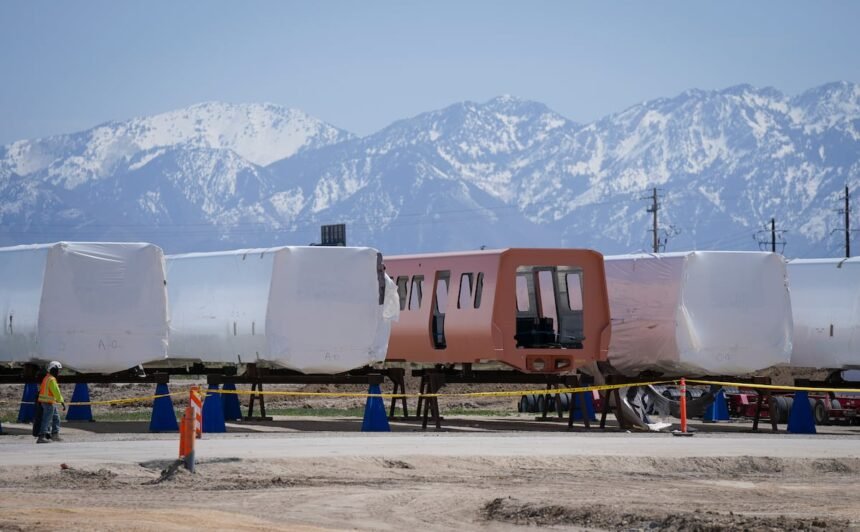City’s transfer of control over the trade zone around its airport could benefit businesses across the state.
(Bethany Baker | The Salt Lake Tribune) Various train car bodies are seen at the Stadler manufacturing facility in Salt Lake City. Stadler is one of more than a dozen companies drawing import-export benefits from operating in the city’s foreign-trade zone by Salt Lake City International Airport.
As part of a shift toward growing existing businesses in Salt Lake City over recruiting new ones, officials quietly handed off control last fall of the city’s foreign-trade zone out by the airport.
Now, with hefty new tariffs being imposed on global trading partners by President Donald Trump, the move has taken on a new dimension.
The trade zone is technically located on land just south of Salt Lake City International Airport, but its effective service area extends for a 60-mile radius. With the city’s official transfer of control in October, what’s called Foreign Trade Zone #30 is now being run by the trade-promoting World Trade Center Utah.
The big bottom line: Certified businesses that locate operations within the zone’s boundaries — under supervision by U.S. Customs agents — can delay, reduce or eliminate the import-export duties and tariffs they pay.
World Trade Center Utah says it has plans to dramatically expand the zone, both geographically and in terms of its economic reach and impact in Utah’s capital and across the state.
Mayor Erin Mendenhall called the zone first created under the late Mayor Ted Wilson in 1977 a “very unique location that you won’t really see on a usual map of the state of Utah, but that impacts our Utah-based economy in a big way.”
“That is only going to grow more with local businesses,” the mayor said Tuesday, “as they launch and scale and reach new heights.”
Mendenhall added it could also bring additional financial stability for Utah firms and jobs relying on global trade at a time when there has been “a great deal of instability in international markets.”
City Council member Victoria Petro, whose District 1 spans the airport, said “removing these trade barriers is the right thing to do” in the name of lifting employment and economic prospects for the blue-collar community she represents.
“This is where economic mobility is,” Petro said, “by creating partners and incentivizing investment here that is going to allow for future homeownership and allow for an evolution in how we treat our workers.”
Keeping more cash local
Nearly 15 companies currently rely on the trade zone’s benefits or have applied for approval, including Swiss train manufacturer Stadler; outdoor retail chain Cabela’s; and Scott USA, maker of mountain bike gear, clothing and accessories.
The zone lets them move materials, components or other goods from international sources into their facilities without paying import duties, then assemble or otherwise add value to them and only pay when those end products are sold or moved elsewhere.
The Salt Lake City-based World Trade Center, where the mission is to grow Utah companies through global networking and boosting international trade, is ramping up its visibility and the roster of companies that might make use of the zone.
Its president and CEO, Jonathan Freedman, said that since the control transfer and the specter of Trump’s tariffs, the pipeline of businesses pursuing a trade zone presence has grown to 100 or more.
“Right now, Utah businesses pay hundreds of millions of dollars to the federal government in duties and taxes,” Freedman said. “Our objective is to keep as much of that capital here locally to fuel the growth of our businesses here to support our entrepreneurs, to fuel job growth and economic prosperity.”
Growing the zone — in size and numbers
That 60-mile service area around the airport covers much of the Wasatch Front, including all of Davis, Morgan, Salt Lake, Weber and Utah counties as well as 32 cities in adjoining counties.
Freedman said World Trade Center Utah hopes to widen that — with the U.S. Department of Commerce’s approval — to cover the whole state.
Salt Lake City’s past stewardship of the foreign-trade zone “has really helped this area be such a great economic hub,” added Jefferson Moss, a former state legislator who now heads the Governor’s Office of Economic Opportunity.
Transferring it under World Trade Center Utah, with its entrepreneurial approach and international business ties, Moss said, “is going to create a lot of new opportunities.”
Another advantage it brings, he added, is speed.
“Having a nimble framework,” he said, “… is going to continue to make sure Utah is an innovation hub and a leader in this space.”











